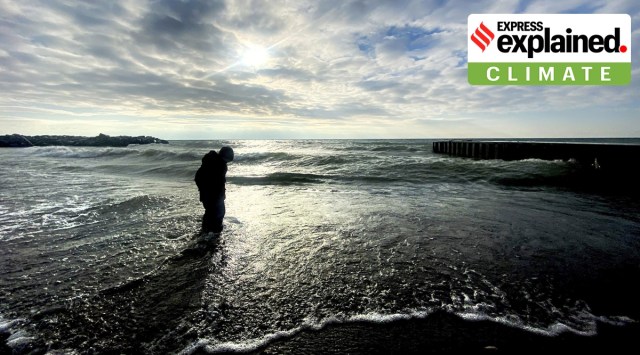US-Canada Great Lakes turning acidic: Study seeks to establish details
Sensors to measure carbon dioxide pressure and pH in a water column have been attached to a floating weather buoy on Lake Huron at Thunder Bay National Marine Sanctuary near Alpena, Michigan.
 A young boy plays in the surf by the shore of Lake Ontario in Toronto. (AP/File)
A young boy plays in the surf by the shore of Lake Ontario in Toronto. (AP/File) Scientists are building a sensor network to detect the trends in the water chemistry of Lake Huron, one of the five Great Lakes of North America, the Associated Press reported on December 19. It is the first step towards developing a system that would be capable of measuring the carbon dioxide and pH levels of the Great Lakes over several years, the report said.
It is known that the increase in atmospheric carbon dioxide has caused the world’s oceans to turn more acidic. Recently, it has been observed that by 2100, even the Great Lakes — Superior, Michigan, Huron, Erie, and Ontario — might approach acidity at around the same rate as the oceans, the AP report said. Researchers hope the data from the Lake Huron project would add to scientific information on the subject.
In order to conduct the study, two sensors have been attached to a floating weather buoy at Thunder Bay National Marine Sanctuary near Alpena, Michigan, in the US. One of them measures carbon dioxide pressure in the water column and the other the pH. Crews are also collecting water samples at varying depths within a 11,137-sq km area for chemical analysis.
The Great Lakes, five interconnected bodies of water straddling the US-Canada border that drain into the Gulf of St Lawrence in the North Atlantic through the St Lawrence River, are the largest group of freshwater lakes in the world. The US-Canada border passes through Lakes Superior, Huron, Erie, and Ontario; Lake Michigan lies entirely in the US. Lakes Michigan and Huron are sometimes considered as a single water body; taken together, they are the world’s largest freshwater lake by surface area. By itself, Lake Huron is the world’s third largest freshwater lake, after Lake Superior and Lake Victoria.
Acidification of water bodies
Acidification of oceans or freshwater bodies takes place when excess carbon dioxide in the atmosphere gets rapidly absorbed into them. Scientists initially believed this might be a good thing, as it leaves less carbon dioxide in the atmosphere. But in the past decade or so, it has been established that absorption of carbon dioxide leads to a lowering of the pH, which makes the water bodies more acidic. According to the National Oceanic and Atmospheric Administration (NOAA) of the US government, oceans have 200 years alone, ocean water has become 30 percent more acidic.
Over the years, a handful of computer modelling studies have suggested that atmospheric carbon might turn the Great Lakes and other freshwater bodies more acidic. However, so far there haven’t been any long-term monitoring programs that are capable of detecting trends in the pH levels of lakes. The Lake Huron project might change that.
Consequences of acidification
The Great Lakes are believed to have been born some 20,000 years ago, when the Earth started to warm and water from melting glaciers filled the basins on its surface, according to NOAA. Today, the Great Lakes contain a fifth of the world’s total freshwater and are a crucial source of irrigation and transportation. The Great Lakes also serve as the habitat for more than 3,500 species of plants and animals.
However, this rich ecosphere is under threat as the five lakes would witness a pH decline of 0.29-0.49 pH units — meaning they would become more acidic — by 2100, assuming current projections of anthropogenic carbon dioxide and constant alkalinity, says NOAA’s Ocean, Coastal, and Great Lakes Acidification Research Plan, which was published in 2020.
In the absence of data, it is difficult to determine the precise consequences of the rise in the acidity of the Great Lakes. Acidification may lead to a decrease in native biodiversity, create physiological challenges for organisms, and permanently alter the structure of the ecosystem, scientists say. It would also severely impact the hundreds of wooden shipwrecks that are believed to be resting at the bottom of these lakes, the AP report said.
In a 2018 study of four German reservoirs, aquatic researchers at Ruhr University Bochum found that their pH levels had declined three times faster in 35 years than in oceans since the Industrial Revolution. As a result of the increase in acidity the ability of water fleas to defend themselves against predators was compromised. Scientists fear that a similar trend might be seen in the Great Lakes as well, the AP report said.
Another study, published in 2021, which looked into the consequences of acidification of freshwater bodies was carried out in Taiwan, where scientists experimented with Chinese mitten crabs. It was found that once the water acidity reaches the projected 2100 levels, it would more than triple the mortality rates of these crabs.
What’s next for the Great Lakes
Scientists have said that without a collective global effort to reduce concentrated atmospheric carbon dioxide, not much can be done to stop the acidification of the Great Lakes. Even if all countries were to take action to arrest the increase in carbon emissions, the lakes would continue to acidify due to the carbon dioxide that is already present in the atmosphere, along with carbon-laden water runoffs from land, the AP report said.
- 01
- 02
- 03
- 04
- 05






































